Submitted:
15 December 2023
Posted:
18 December 2023
You are already at the latest version
Abstract
Keywords:
1. Introduction
2. Basics on Optical Networks and Physical Impairments
2.1. The concept of WDM
2.2. Optical Network Architecture
2.3. Major Physical Impairments
3. Channel Capacity
3.1. Capacity of a Communication Channel
3.2. Capacity of an Optical Channel
3.3. Optical reach evaluation with the Gaussian model
4. Link and Network Capacity
4.1. Link capacity
4.2. Network capacity
- 1)
-
Compute the shortest-paths:
- Use the Dijkstra's algorithm to find the shortest-path for each source-destination pair in the network;
- The total path length is considered as a metric for determining the shortest paths.
- 2)
-
Order the traffic demands:
- Apply a specific sorting strategy (e.g. shortest-first, longest-first, largest-first) to order traffic demands .
- 3)
-
Route the demands:
- Route the demands through the precomputed shortest-paths obtained in Step 1;
- The routing is done according to the orderings considered in Step 2.
- 4)
-
Update residual capacities:
- Whenever a demand is routed, update the residual capacities of all the links traversed by the demand;
- Residual capacity is defined as the difference between the link capacity and its load (number of demands already routed through the link).
- 5)
-
Path selection and blocking:
- Firstly, attempt to use the shortest-path obtained in Step 1 for each traffic demand;
- Check the values of residual capacities of all links on the path. If there is enough capacity use the path;
- If the residual capacities do not allow using the precomputed path find an alternative shortest-path;
- If the computing of an alternative path is not possible, because there is not enough capacity, the traffic demand will be blocked.
5. Conclusions
Funding
Data Availability Statement
Conflicts of Interest
Appendix A
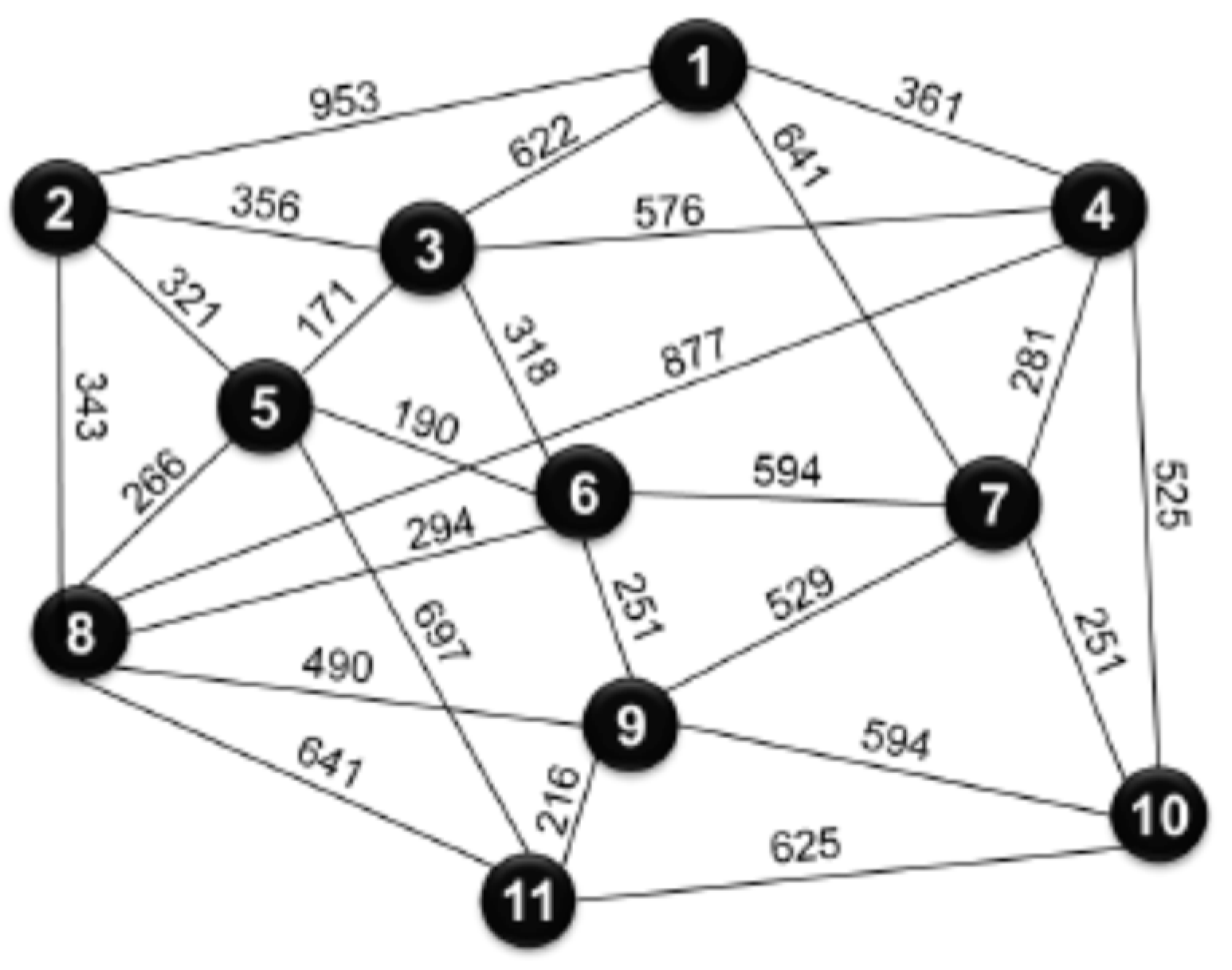
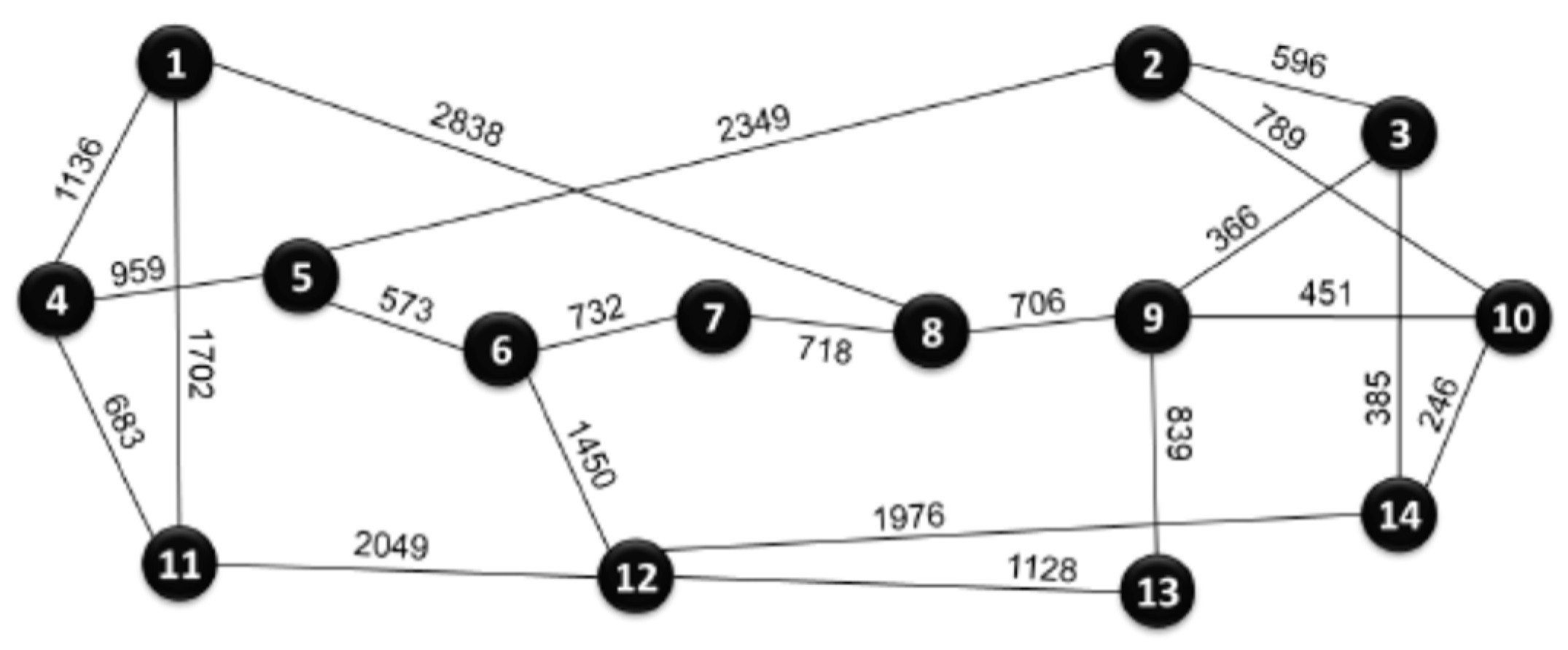
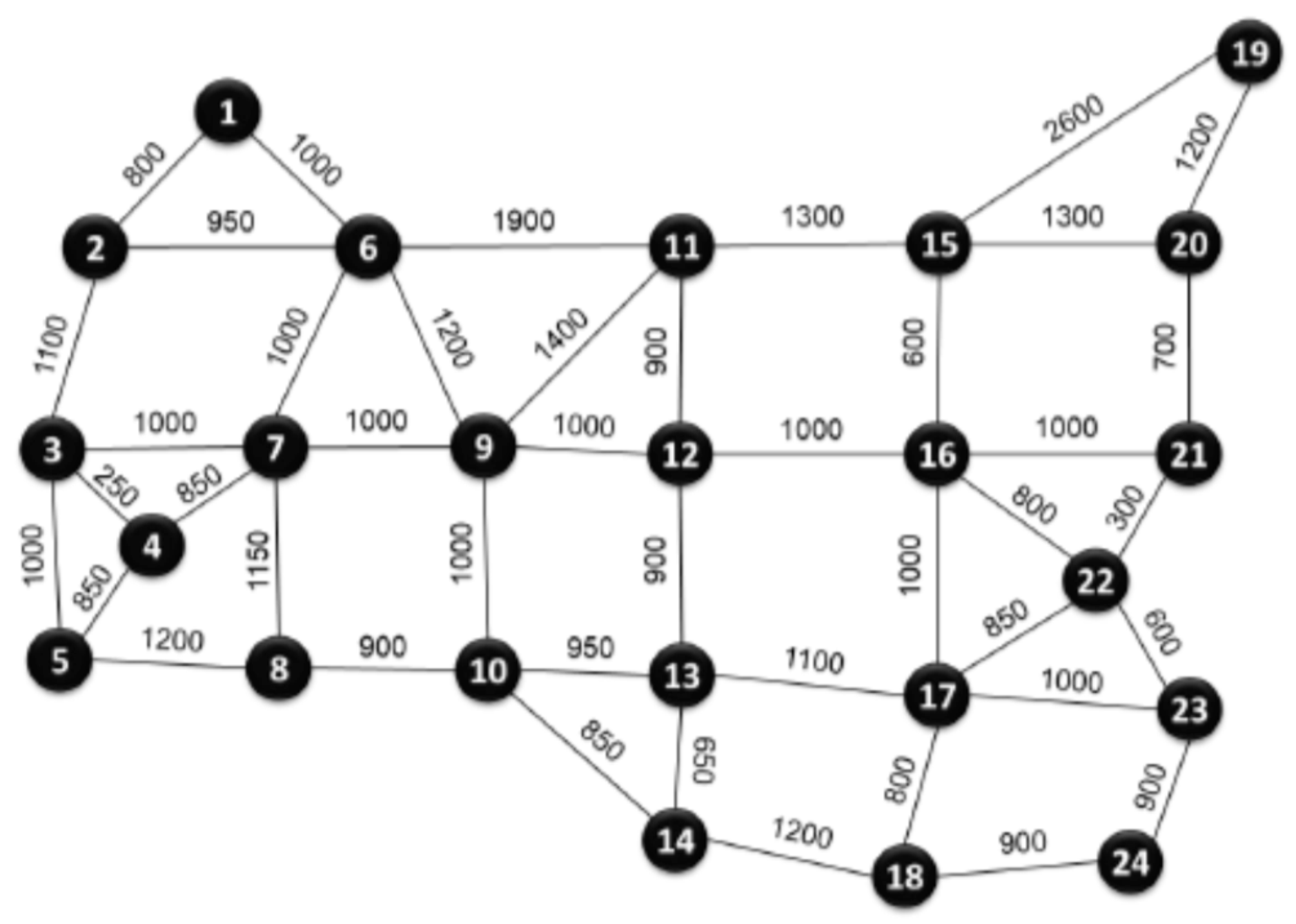
References
- Winzer, P. J.; Neilson, D. T. From Scaling Disparities to Integrated Parallelism: A Decathlon for a Decade. J. Lightw.Technol. 2017, 35, 1099–1115. [Google Scholar] [CrossRef]
- Autenrieth, A. Efficient Optical Packet Transport in Access, Metro, and Core Networks. Proc. Opt. Fiber Commun. Conf. Paper OTuP3, Los Angeles, California, USA, 6-10 March 2011.
- Kao, K. C.; Hockham, G. A. Dielectric-fibre surface waveguides for optical frequencies. Proceedings of the IEE 1966, 113, 1151–1158. [Google Scholar] [CrossRef]
- Essiambre, R.-J.; Tkach, R. W. Capacity Trends and Limits of Optical Communication Networks. Proceedings of the IEEE 2012, 100, 1035–1055. [Google Scholar] [CrossRef]
- Winzer, P. J.; Neilson D., T.; Chraplyvy, A. R. Fiber-optic transmission and networking: the previous 20 and the next 20 years. Optics Express 2018, 26, 24190–24239. [Google Scholar] [CrossRef] [PubMed]
- Shannon C., E. A Mathematical Theory of Communication. The Bell System Technical J. 1948, 27, 349-423, 626-656. [Google Scholar] [CrossRef]
- Mitra, P. P.; Stark, J. B. Nonlinear limits to the information capacity of optical fiber communications. Nature 2001, 411, 1027–1030. [Google Scholar] [CrossRef] [PubMed]
- Ellis, A. D.; Zhao, J.; Cotter, D. Approaching the Non-Linear Shannon Limit. J. Lightw.Technol. 2010, 28, 423–433. [Google Scholar] [CrossRef]
- Essiambre, R.-J.; Kramer, G.; Winzer P., J.; Foschini G., J.; Goebel, B. Capacity limits of optical fiber networks. J. Lightw.Technol. 2010, 28, 662–701. [Google Scholar] [CrossRef]
- Bosco, G.; Poggiolini, P.; Carena, A.; Curri, V.; Forghieri, F. Analytical results on channel capacity in uncompensated optical links with coherent detection. Opt. Express 2011, 19, B438–B449. [Google Scholar] [CrossRef]
- Poggiolini, P.; Bosco, G.; Carena, A.; Curri, V.; Jiang, Y.; Forghieri, F. The GN-Model of Fiber Non-Linear Propagation and its Applications. J. Lightw.Technol. 2014, 32, 694–721. [Google Scholar] [CrossRef]
- Bayvel, P.; et al. Maximizing the optical network capacity. Phil. Trans. R. Soc, A. 2016, 374, 2014044. 1–34. [Google Scholar] [CrossRef] [PubMed]
- Mocozzi, A.; Essiambre, R. -J. Nonlinear Shannon Limit in Pseudolinear Coherent Systems. J. Lightw.Technol. 2012, 30, 2011–2024. [Google Scholar] [CrossRef]
- Souza A.; Correia, B.; Costa, N.; Pedro, J.; Pires, J. Accurate and scalable quality of transmission estimation for wideband optical systems. Proc. IEEE 26th Int. Work. on Comp. Aid. Mod. and Design. of Comm. Links and Networks, 25-27 Oct. 2021.
- Vincent, R. J.; Ives, D. J.; Savory S., J. ; Scalable Capacity Estimation for Nonlinear Elastic All-Optical Core Networks. J. Lightw.Technol. 2019, 37, 5380–5391. [Google Scholar] [CrossRef]
- Ives, D. J.; Bayvel, P.; Savory, S. J. Routing, Modulation, Spectrum and Launch Power Assignment to Maximize the Traffic Throughput of a Nonlinear Optical Mesh Network. Photon. Netw. Commun. 2015, 29, 244–256. [Google Scholar] [CrossRef]
- Matzner, R.; Semrau, D.; Luo, R.; Zervas, G.; Bayvel, P. Making intelligent topology design choices: understanding structural and physical property performance implications in optical networks. J. Opt. Commun. Netw. 2021, 13, D53–D67. [Google Scholar] [CrossRef]
- Deng, N.; Zong, L.; Jiang, H.; Duan, Y.; Zhang, K. Challenges and Enabling Technologies for Multi-Band WDM Optical Networks. J. Lightw. Technol. 2022, 40, 3385–3394. [Google Scholar] [CrossRef]
- Santos, J. R.; Eira, A.; Pires, J. A Heuristic Algorithm for Designing OTN Over Flexible-Grid DWDM Networks. J. of Communications 2017, 12, 500–509. [Google Scholar] [CrossRef]
- Rahman, T. , et al. On the Mitigation of Optical Filtering Penalties Originating from ROADM Cascade. IEEE Photonics Technol. Lett. 2014, 26, 154–157. [Google Scholar] [CrossRef]
- Chentsho, P.; Cancela, L. G. C.; Pires, J. J. O. A framework for analyzing in-band crosstalk accumulation in ROADM-based optical networks. Opt. Fiber Technol. 2020, 57, 102238. [Google Scholar] [CrossRef]
- Carena, A.; Curri, V.; Bosco, G.; Poggiolini, P.; Forghieri, F. Modeling of the Impact of Nonlinear Propagation Effects in Uncompensated Optical Coherent Transmission Links. J. Lightw. Technol. 2012, 30, 1524–1539. [Google Scholar] [CrossRef]
- Poggiolini, P.; Carena, A.; Curri, V.; Bosco, G.; Forghierim, F. Analytical Modeling of Nonlinear Propagation in Uncompensated Optical Transmission Links. IEEE Photonics Technol. Lett. 2011, 23, 742–744. [Google Scholar] [CrossRef]
- Gené, J. M.; Perelló, J.; Cho, J.; Spadaro, S. Practical Spectral Efficiency Estimation for Optical Networking. Proc. Int. Conf. Transp. Opt. Networ. Paper Tu.A3.1, Bucharest, Romania, 2-6 July 2023.
- Olsson, S. L. I; Cho, J.; Chandrasekhar, S.; Chen, X.; Burrows, E. C.; Winzer, P. J. Record-High 17.3-bit/s/Hz Spectral Efficiency Transmission over 50 km Using Probabilistically Shaped PDM 4096-QAM. Proc. Opt. Fiber Commun. Conf. Paper Th4C.5, San Diego, California, USA, 11-15 March 2018.
- Chandrasekhar, S.; Li, B.; Cho, J.; Chen, X.; Burrows, E. C.; Raybon, G.; Winzer, P. J. High-spectral-efficiency transmission of PDM 256-QAM with Parallel Probabilistic Shaping at Record Rate-Reach Trade-offs. Proc. Eur. Conf. Opt. Commun. Paper Th.3.C, Dusseldorf, Germany, 18-22, Sept. 2016.
- Poggiolini. P.; Jiang, Y.; Carena, A.; Bosco, G.; Forghieri, F. Analytical results on system maximum reach increase through symbol rate optimization. Proc. Opt. Fiber Commun. Conf. Paper Th3D, Los Angeles, California, USA, 22-26 March 2015.
- Frey, F.; Elschner, R.; Fische J. K. Estimation of Trends for Coherent DSP ASIC Power Dissipation for different bitrates and transmission reaches. Photonic Netw. 137-144, Leipzig, Germany, 11, 12, May 2017.
- Li, S.-A; et al. Enabling Technology in High-Baud-Rate Coherent Optical Communication Systems. IEEE Access 2020, 8, 2020. [Google Scholar] [CrossRef]
- Chen, X.; Raybon, G.; Che D.; Cho, J.; Kim, K. W. Transmission of 200-GBaud PDM Probabilistically Shaped 64-QAM Signals Modulated via a 100-GHz Thin-film LiNbO3 I/Q Modulator. Proc. Opt. Fiber Commun. Conf. Paper F3C.5, São Francisco, California, USA, 6-10 June 2021.
- Yamazaki, H. et al. Transmission of 160.7-GBaud 1.64-Tbps Signal Using Phase-Interleaving Optical Modulator and Digital Spectral Weaver. Proc. Eur. Conf. Opt. Commun. Paper We3D.2, Basel, Switzerland, 18–22 Sep. 2022.
- Pires, J. J. O.; Cancela, L. G. C. Investigating the Impact of Coherent Multipath Interference on Optical QPSK Systems. IEEE ICC Opt. Net. Syst. Symp. 2017, Paris, France, 21-25 May 2017.
- Cho, K.; Yon, D. On the General BER Expression of One- and Two-Dimensional Amplitude Modulations. IEEE Trans. Commun. 2002, 50, 1075–1080. [Google Scholar]
- Zami, T.; Lavigne, B.; Bertolini, M. How 64 GBaud Optical Carriers Maximize the Capacity in Core Elastic WDM Networks with Fewer Transponders per Gb/s. J. Opt. Commun. Netw. 2019, 11, A20–A32. [Google Scholar] [CrossRef]
- Idler, A.; Buchali, F.; Schuh K., Experimental Study of Symbol-Rates and MQAM Formats for Single Carrier 400 Gb/s and Few Carrier 1 Tb/s Options. Proc. Opt. Fiber Commun. Conf. Paper Tu3A.7, Anaheim, California, United USA, 20-24 March 2016.
- Matsushita, A.; Nakamura, M.; Yamamoto, S.; Hamaoka, F.; Kisaka, Y. 41-Tbps C-Band WDM Transmission With 10-bps/Hz Spectral Efficiency Using1-Tbps/λ Signals. J. Lightw. Technol. 2020, 38, 2905–2911. [Google Scholar]
- Buchali, F.; Aref, V.; Chagnon, M.; Dischler, R.; Hettrich, H.; Schmid, R.; Moeller, M. 52.1 Tb/s C-band DCI transmission over DCI distances at 1.49 Tb/s/λ. Proc. Eur. Conf. Opt. Commun. Paper Mo1E-4, Brussels, Belgium, 6-20 Dec. 2020.
- Pires, J. J. O.; O´Mahony, M.; Parnis, N.; Jones, E. Scaling limitations in full-mesh WDM ring networks using arrayed-waveguide grating OADMs. Electronics Letters 1999, 35, 73–75. [Google Scholar] [CrossRef]
- Pióro, M.; Medhi, D. Design Modeling and Methods. In Routing, Flow, and Capacity Design in Communication and Computer Networks; Morgan Kaufman Publishers, Elsevier: San Francisco, CA, USA, 2004; pp. 105–149. [Google Scholar]
- Freitas, A. Channel and Network Capacity. Report, IST, Universidade de Lisboa, Portugal, October 2023.
- Ribeiro, J. Machine Learning Techniques for Designing Optical Networks to Face Future Challenges. MSc Thesis on Electrical and Computer Engineering, IST, University of Lisboa, Lisboa, Portugal, June 2023.

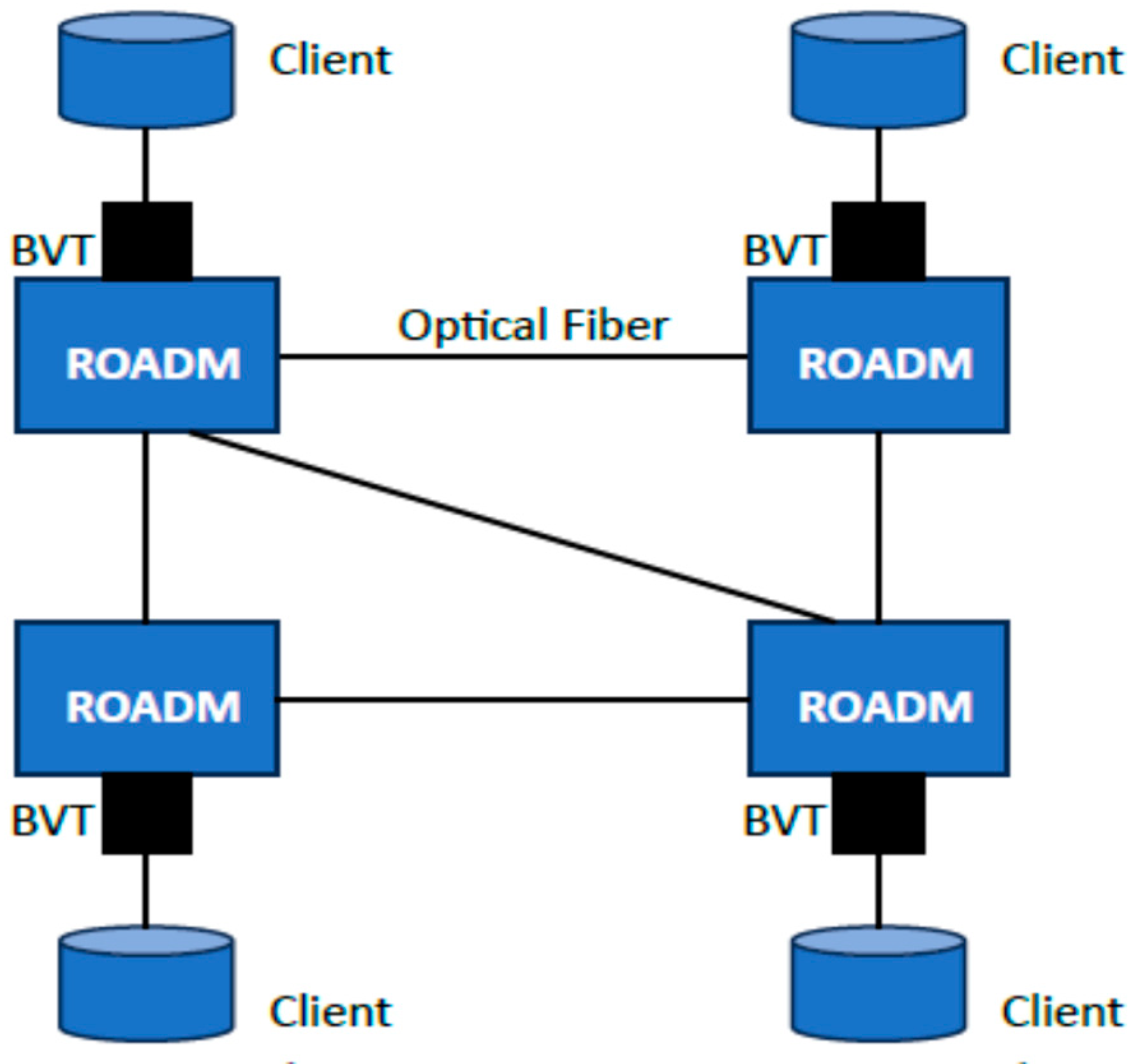
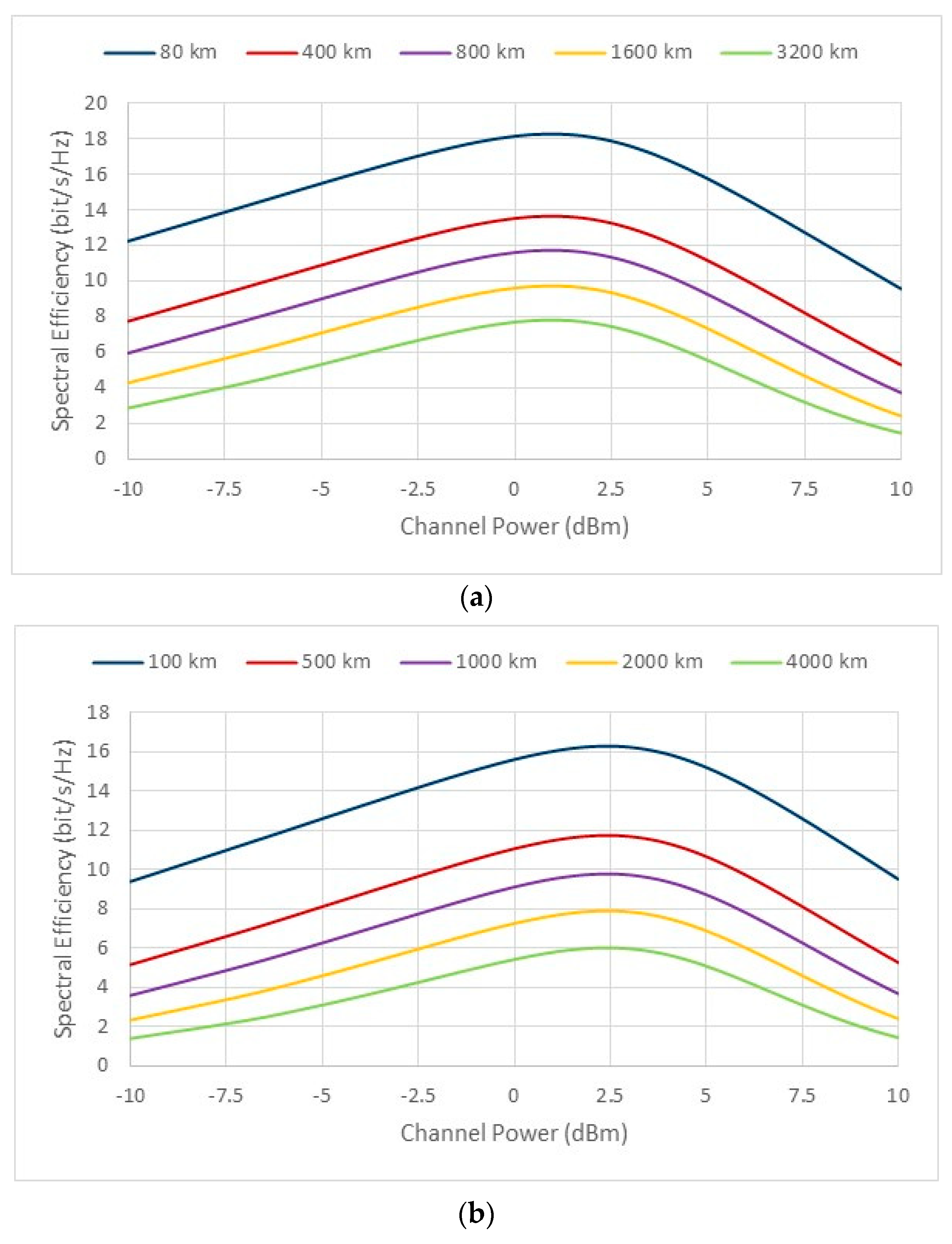
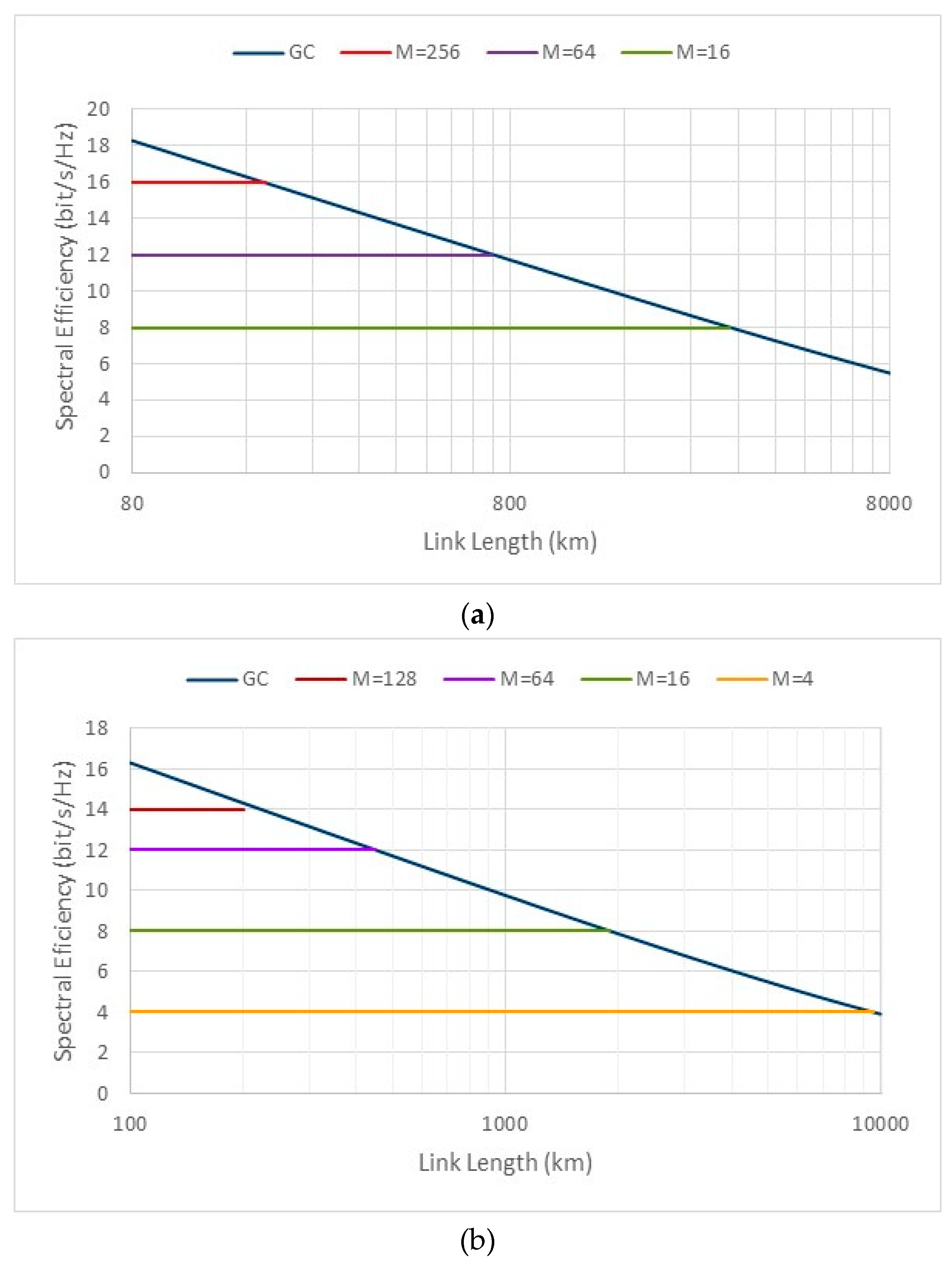
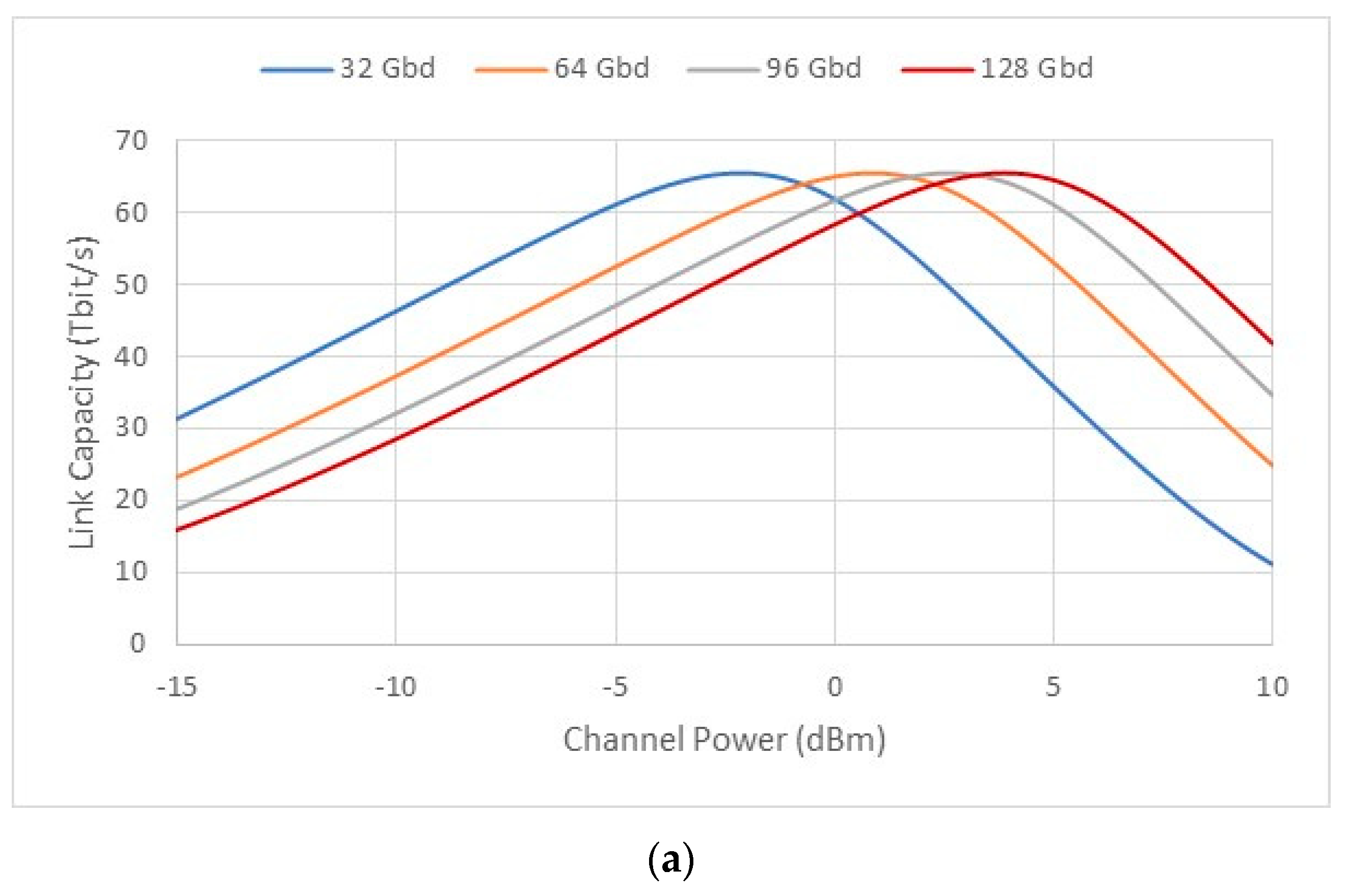
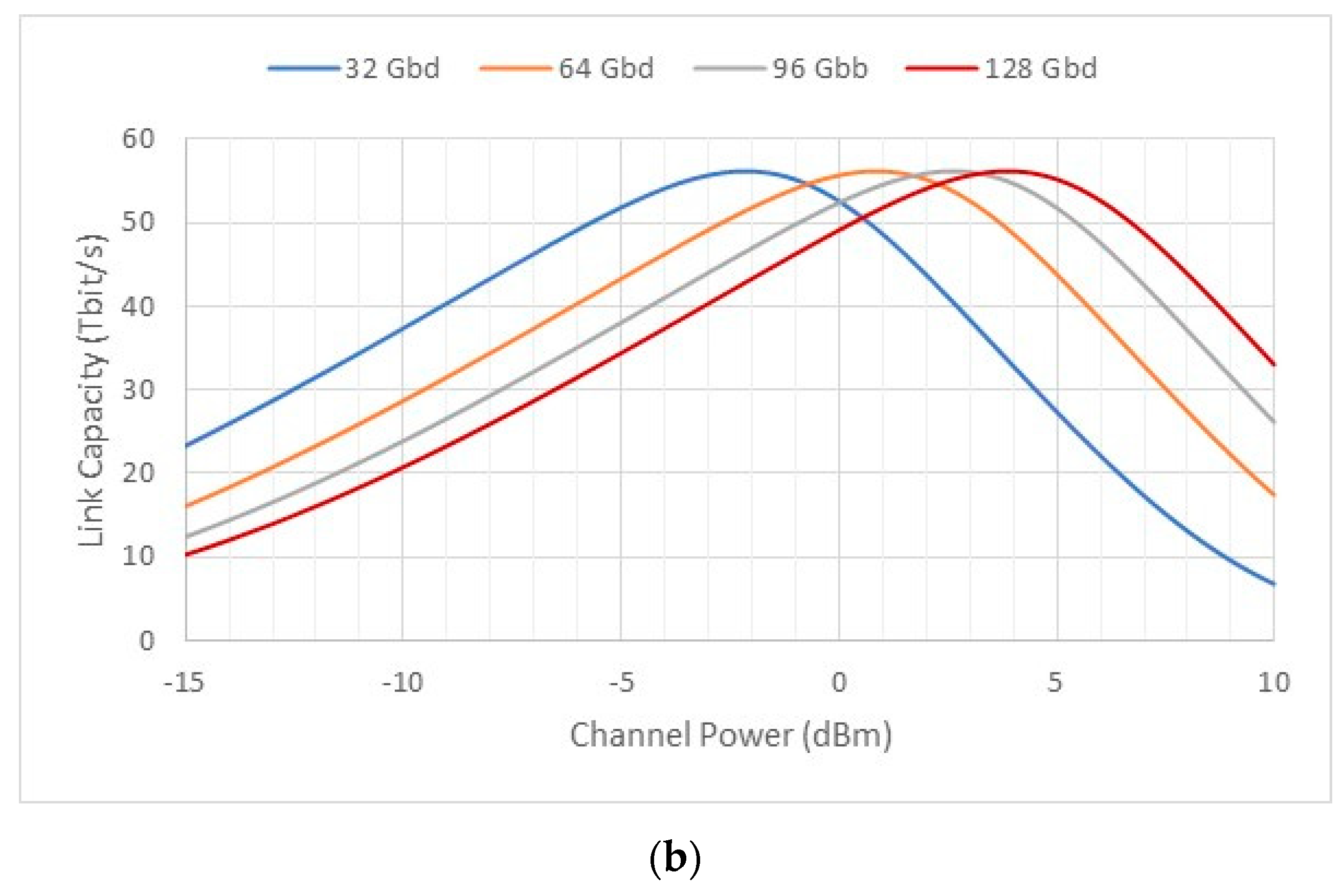
| Parameter | Symbol | Value |
|---|---|---|
| Fiber Attenuation Coefficient | ||
| Fiber Dispersion Coefficient | ||
| Fiber Nonlinear Coefficient | ||
| Carrier Frequency | ||
| Carrier Wavelength | ||
| Span length | ||
| EDFA noise figure | ||
| Symbol rate | ||
| Channel Spacing | ||
| Number of Channels | ||
| WDM bandwidth |
| Number of Symbols (M) |
SE (bit/s/Hz) |
(Gbit/s) |
Reach (km) = 80 km |
Reach (km) = 100 km |
|---|---|---|---|---|
| 4 | 4 | 256 | 15100 | 9500 |
| 16 | 8 | 512 | 3020 | 1900 |
| 64 | 12 | 768 | 720 | 450 |
| 128 | 14 | 896 | 360 | 225 |
| 256 | 16 | 1024 | 180 | -------- |
| Modulation | SNR (dB) |
|---|---|
| BPSK | 6.77 |
| QPSK | 9.78 |
| 8QAM | 14.38 |
| 16QAM | 16.54 |
| 32QAM | 20.56 |
| 64QAM | 22.55 |
| 128QAM | 26.44 |
| Modulation | Data Bit Rate (Gbit/s) |
Reach (km) = 80 km |
Reach (km) = 100 km |
|---|---|---|---|
| PM-BPSK | 100 | 9500 | 6000 |
| PM-QPSK | 200 | 4750 | 3000 |
| PM-8QAM | 300 | 1650 | 1050 |
| PM-16QAM | 400 | 1000 | 650 |
| PM-32QAM | 500 | 400 | 250 |
| PM-64QAM | 600 | 250 | 150 |
| PM-128 QAM | 700 | 100 | ----- |
| Symbol rate (Gbaud) |
(Tb/s) |
(Tb/s) |
(dBm) | (dBm) | |
|---|---|---|---|---|---|
| 32 | 150 | 0.44 | 0.37 | -2.15 | 19.61 |
| 64 | 75 | 0.88 | 0.75 | 0.89 | 19.64 |
| 96 | 50 | 1.31 | 1,12 | 2.65 | 19.64 |
| 128 | 37 | 1.77 | 1.52 | 3.89 | 19.57 |
| Symbol (Gbaud) |
|
(b/s/Hz) |
(Tb/s) |
(Tb/s) |
L (km) | Ref. | ||
|---|---|---|---|---|---|---|---|---|
| 32 | 117 | 4400 | 37.5 | 6.7 | 0.25 | 29.25 | 1600 | [35] |
| 64 | 59 | 4400 | 75.0 | 6.7 | 0.50 | 29.50 | 650 | [35] |
| 96 | 41 | 4100 | 100.0 | 10.0 | 1.00 | 41.00 | 100 | [36] |
| 128 | 35 | 4800 | 137.5 | 10.9 | 1.49 | 52.15 | 80 | [37] |
| Networks | Average path length (km) |
(80 km) (Gb/s |
(100 km) (Gb/s) |
( 80 km) |
( 100 km) (Tb/s) |
|---|---|---|---|---|---|
| COST239 | 682.2 | 410.9 | 340.0 | 45.2 | 37.4 |
| NSFNET | 2268.3 | 258.2 | 200.0 | 47.0 | 36.4 |
| UBN | 2995.9 | 216.6 | 168.1 | 119.6 | 92.8 |
| Networks | Average path length( km) |
(80 km) (Gb/s |
(100 km) (Gb/s) |
( 80 km) |
(100 km) (Tb/s) |
|---|---|---|---|---|---|
| COST239 | 682.2 | 752.3 | 672.7 | 82.8 | 74.0 |
| NSFNET | 2268.3 | 541.8 | 459.3 | 98.6 | 83.6 |
| UBN | 2995.9 | 496.4 | 418.1 | 274.0 | 230.8 |
Disclaimer/Publisher’s Note: The statements, opinions and data contained in all publications are solely those of the individual author(s) and contributor(s) and not of MDPI and/or the editor(s). MDPI and/or the editor(s) disclaim responsibility for any injury to people or property resulting from any ideas, methods, instructions or products referred to in the content. |
© 2023 by the authors. Licensee MDPI, Basel, Switzerland. This article is an open access article distributed under the terms and conditions of the Creative Commons Attribution (CC BY) license (http://creativecommons.org/licenses/by/4.0/).




